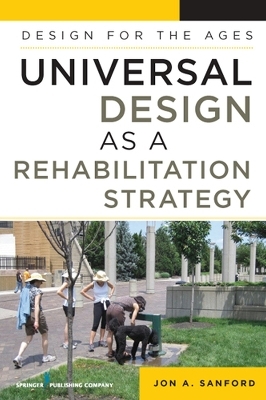
Universal Design as a Rehabilitation Strategy
Springer Publishing Co Inc (Verlag)
978-0-8261-2552-1 (ISBN)
- Titel ist leider vergriffen;
keine Neuauflage - Artikel merken
This professional clinical text is written by an experienced authority in the field, Jon A. Sandford. Sanford is Co-Director of the National Institute on Disability and Rehabilitation Research (NIDRR) and is one of the few architecturally trained researchers engaged in environmental issues related to accessibility and design for aging. In this unique resource, Sanford examines key social ecological models in the rehabilitation for aging and disability, and sheds new light on health and disability at both the individual and population level.
Design for the Ages addresses three core knowledge areas important to the contemporary practice of rehabilitation counselling:
Medical, functional, and environmental implications of disability
Healthcare and disability systems
Psychosocial and cultural issues
This textbook is a useful tool for rehabilitation engineers, occupational/ physical therapists, engineer psychologists, environmental psychologists, rehabilitation counsellors, disability and rehabilitation researchers, assistive technology practitioners (ATP), gerontologists, educators and students in nursing, case managers, home builders, design professionals (product designers, interior designers, and architects), and design educators/students in planning.
Jon Sanford is an adjunct Associate Professor of Architecture and Co-Director of the National Institute on Disability and Rehabilitation Research (NIDRR) funded Rehabilitation Engineering Research Center on Workplace Accommodations within the Center for Assistive Technology and Environmental Access, Georgia Institute of Technology. He is also a Research Architect at the Rehabilitation Research and Development Center at the Atlanta Veterans Affairs Medical Center and the Director of Research for Extended Home Living Services in Wheeling, Illinois, one of the nationâ s largest providers of home modifications. Mr. Sanford is one of the few architecturally trained researchers engaged in environmental issues related to accessibility and design for aging and has been well-recognized for his expertise in home modifications, environmental safety, and universal design for over 20 years. His research has focused on accessibility and universal design, including best practices in assisted toileting and bathing; access to toilet and bathing facilities; and design of toilet facilities to facilitate independence among older adults. He has developed several assessment protocols for home modifications, including remote assessments using televideo technology and CASPAR, the Comprehensive Assessment and Solutions Process for Aging Residents. He is currently funded by the National Institute on Aging to develop eCASPAR, a companion database of home modification solutions. In addition, he is currently directing a multi-site, randomized controlled trial to evaluate the efficacy of using interactive teleconferencing to provide remote therapeutic services, including home modification recommendations, to older adults at home. He has contributed over 100 articles and chapters to the professional literature; over 150 professional presentations; and over 50 principal or co-investigator and director positions. In addition, a select listing of his memberships and contributions to professional associations/ are provided below: Expert/Advisory Panels. Home Safety Workgroup, National Council on Aging (2006-); UIC Activity and Environment Advisory Panel (2006); AIA Task Force on ADA (2005); National Falls Prevention Summit to develop Falls Prevention Action Plan, National Council on Aging (2004). Emergency Evacuation of People with Physical Disabilities from Buildings, Interagency Committee on Disability Research (2004). VA Design Guide for Extended Care Facilities, Ernest Bland Associates (2004). Envisioning the Future, American Occupational Therapy Association (2004). Professional Associations. Gerontological Society of America: Member 1989-Present, Physical Environments and Aging Informal Interest Group, 1994-Present; Chair, 2005 - present; American Society on Aging, 1993-Present; Network on Environments Services and Technologies, 1994-present; ASA local arrangements committee, 1994; program planning committee 2003; Environmental Design Research Association 1975-present, Gerontology Network, 1987-present; Rehabilitation Engineering Society of North America (1994-Present), Universal Access Special Interest Group (1995- present). Editorial Boards. Journal of Physical and Occupational Therapy in Geriatrics, 2006; Maximizing Human Potential, newsletter for Network on Environments, Services and Technologies for Maximizing Independence of the American Society on Aging, 2000; Co-editor, Design Research News, Environmental Design Research Association,1995-2001.
Part 1. Form, Function and Design
Chapter 1. The Function of Form: The Link between Design and Rehabilitation
Chapter 2. The Fiasco of Form: Disabling Design
Chapter 3. Function follows Fiasco: Enabling Disabling Design
Chapter 4. Form follows Function: Enabling Design
Part 2. Universal Design as a Rehabilitation Strategy at Home, Work and Play
Chapter 5. Universal Design as a Rehabilitation Strategy for Aging in Place
Chapter 6. Universal Design as a Rehabilitation Strategy for Aging in the Workplace
Chapter 7. Livable Communities. Universal Design as a Rehabilitation Strategy for Aging in Play
Part 3. Design for the Ages: Universal Design as a Change Agent
Chapter 8. Social and Health Movements that Promote Performance and Participation
Chapter 9. Universal Design as the Basis for Change
| Verlagsort | New York |
|---|---|
| Sprache | englisch |
| Gewicht | 550 g |
| Themenwelt | Medizin / Pharmazie ► Medizinische Fachgebiete ► Geriatrie |
| Medizin / Pharmazie ► Physiotherapie / Ergotherapie ► Rehabilitation | |
| Sozialwissenschaften ► Soziologie | |
| ISBN-10 | 0-8261-2552-2 / 0826125522 |
| ISBN-13 | 978-0-8261-2552-1 / 9780826125521 |
| Zustand | Neuware |
| Haben Sie eine Frage zum Produkt? |
aus dem Bereich


